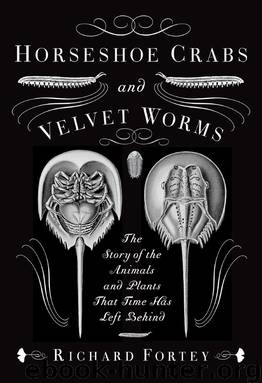Horseshoe Crabs and Velvet Worms by Richard Fortey

Author:Richard Fortey [Fortey, Richard]
Language: eng
Format: epub
ISBN: 978-0-307-95741-2
Publisher: Knopf Doubleday Publishing Group
Published: 2012-04-09T16:00:00+00:00
The original draft of the poem survives, with a pair of Ginkgo biloba leaves charmingly crossed at the bottom of the page, but, sadly, Goethe’s original tree does not.
The ginkgo tree is also at a crossroads in the evolutionary sense. It is certainly a primitive plant, and inserts low down in the tree of life, but the question remains where and what are its closest relatives. Different lines of evidence suggest several candidates. The fertilisation of the ginkgo female ovule by swimming male sperm was demonstrated in 1896 by Sakugoro Hirase in the Tokyo Botanical Garden, and could be said to mark the beginning of scientific botany in Japan. The discovery that the sperm of ginkgo swam with a flagellated “tail” is recorded in a plaque in Tokyo even today, although when I was there this memorial was largely ignored by thousands in search of pretty cherry blossoms. Such a mode of fertilisation is evidently primitive, and the flagellated sperm cells are similar to those of another group of plants surviving from the Age of Dinosaurs known as cycads. These are tough plants that are frequently cultivated as pot plants, for they are long lived, tough, and happily tolerate city life. Both cycads and ginkgos were much more diverse 100 million years ago, and it might seem appropriate at first to assume that they were closely related. Together with conifers and an interesting plant called Gnetum, cycads and ginkgo comprise the gymnosperms, that is, plants in which the female “seeds” are naked and exposed in the unfertilised state. However, when Zhiyan Zhou reviewed the state of the science in 2009, he favoured another theory in which ginkgo is partnered with early conifers and an even older, Carboniferous tree called Cordaites, taking us back almost to the dawn of forests themselves. The shape of the answer depends how the investigator interprets and tots up the characteristics of wood, fertile shoots, pollen and embryology in all these plants, including fossils, for which data may be incomplete. It is rare for different specialists to agree on all such characters, and different interpretations result in different evolutionary trees. At this point in the story new evidence from the molecular sequences often comes to the rescue. However, even this evidence is not unequivocal. One Japanese researcher in 1997 apparently found much evidence to reaffirm the ginkgo–cycad connection, but other molecular studies joined the old survivor with primitive conifers. In a way, these very ambiguities point up the singular importance of ginkgo as an intermediate form—why should evolution make it so easy to read the signposts as if at a simple fork in the road? This odd survivor might have borrowed features from more than one evolutionary line, while retaining a whole lot of primitive characters just to further muddy the waters. Trying to parse the language of events that happened more than 280 million years ago was never going to be easy. Unresolved mysteries are all part of the allure of the ancient tree.
Cycads, too, are successful survivors from the Mesozoic.
Download
This site does not store any files on its server. We only index and link to content provided by other sites. Please contact the content providers to delete copyright contents if any and email us, we'll remove relevant links or contents immediately.
| Cell Biology | Developmental Biology |
| Entomology | Marine Biology |
| Microbiology | Molecular Biology |
| Biostatistics |
Sapiens: A Brief History of Humankind by Yuval Noah Harari(14319)
The Tidewater Tales by John Barth(12625)
Mastermind: How to Think Like Sherlock Holmes by Maria Konnikova(7278)
Do No Harm Stories of Life, Death and Brain Surgery by Henry Marsh(6905)
The Thirst by Nesbo Jo(6877)
Why We Sleep: Unlocking the Power of Sleep and Dreams by Matthew Walker(6654)
Life 3.0: Being Human in the Age of Artificial Intelligence by Tegmark Max(5512)
Sapiens by Yuval Noah Harari(5322)
The Longevity Diet by Valter Longo(5040)
The Body: A Guide for Occupants by Bill Bryson(5027)
The Rules Do Not Apply by Ariel Levy(4910)
The Immortal Life of Henrietta Lacks by Rebecca Skloot(4548)
Animal Frequency by Melissa Alvarez(4424)
Why We Sleep by Matthew Walker(4394)
The Hacking of the American Mind by Robert H. Lustig(4338)
Yoga Anatomy by Kaminoff Leslie(4332)
All Creatures Great and Small by James Herriot(4269)
Double Down (Diary of a Wimpy Kid Book 11) by Jeff Kinney(4240)
Embedded Programming with Modern C++ Cookbook by Igor Viarheichyk(4141)
